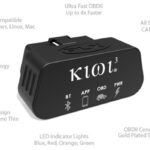Navigating the world of automotive diagnostics can be confusing, especially when dealing with different vehicle ages and diagnostic systems. A common question that arises, particularly for those working with older vehicles, is whether modern OBD2 scanners are compatible with older OBD (pre-OBD2) systems. Let’s clarify the compatibility between these systems and what you need to know when diagnosing older vehicles.
Understanding OBD and OBD2
Before diving into compatibility, it’s important to understand the basics of On-Board Diagnostics (OBD) and its evolution to OBD2. OBD was the early standard implemented in vehicles to monitor engine and emission control systems. These early systems were not standardized, meaning each manufacturer could have different connectors, communication protocols, and diagnostic trouble codes.
OBD2, short for On-Board Diagnostics II, is a standardized system introduced in the mid-1990s in the United States, and subsequently adopted in other parts of the world. The key difference with OBD2 is standardization. It mandates a universal connector (SAE J1962), a set of diagnostic trouble codes (DTCs), and standardized communication protocols. This standardization was designed to make vehicle diagnostics more consistent and accessible.
OBD2 Scanner Compatibility with Older OBD Systems
The straightforward answer to whether an OBD2 scanner connects to old OBD systems is generally no, not directly. OBD2 scanners are designed to communicate with vehicles that adhere to the OBD2 standard. Older OBD systems, lacking this standardization, operate on different protocols and use different connectors.
Physically, the connectors are different. OBD2 systems use a 16-pin trapezoidal connector, while older OBD systems could use various connectors, including 3-pin, 4-pin, or even 12-pin connectors, depending on the manufacturer and model year. Electrically and protocol-wise, OBD2 scanners communicate using protocols like CAN, PWM, VPW, and ISO 9141-2, which are not typically compatible with the proprietary protocols used in pre-OBD2 systems.
Bridging the Gap: Adapters and Legacy Tools
While direct connection isn’t possible, there are ways to diagnose older vehicles.
-
Adapters: For some older vehicles, especially those immediately preceding the OBD2 standardization, adapters might exist. These adapters convert the older connector type to the OBD2 16-pin connector. However, it’s crucial to understand that an adapter only changes the physical connector. It does not bridge the communication protocol gap. Therefore, simply using an adapter will likely not enable an OBD2 scanner to read data from a truly pre-OBD2 vehicle.
-
Legacy Diagnostic Tools: For proper diagnosis of older vehicles, especially those with pre-OBD2 systems, you often need to use legacy diagnostic tools specifically designed for those vehicles. These tools are equipped with the correct connectors, communication protocols, and software to interface with the older systems. Think of older scan tools or specialized dealer tools from the era of those vehicles.
-
OBD1 to OBD2 Conversion in Scan Tools: Some older scan tools, like the MT2500 mentioned in the original context, were designed to work with both OBD and early OBD2 systems through the use of different cartridges and cables. These tools often used interchangeable cartridges for model-specific coverage and generic OBD capabilities. However, even these tools have limitations in terms of coverage for very modern vehicles.
Considerations for Diagnosing Older Vehicles
If you frequently work on vehicles from before the mid-1990s:
- Identify the System: Determine the specific diagnostic system your older vehicle uses. It might be manufacturer-specific OBD or an early version of OBD that’s not fully OBD2 compliant.
- Check for Adapters (with Caution): Research if there are any reliable adapters for your specific vehicle make and model. Be aware that compatibility can be limited.
- Consider Legacy Tools: For comprehensive diagnostics, especially for pre-OBD2 vehicles, investing in or accessing legacy diagnostic tools designed for those systems might be necessary.
- Consult Vehicle-Specific Information: Always refer to the vehicle’s service manual or repair information for guidance on diagnostics, as procedures and compatibility can vary widely among older makes and models.
Conclusion
In summary, standard OBD2 scanners are not designed to connect directly to old OBD systems due to differences in connectors and communication protocols. While adapters might exist for some transitional vehicles, they don’t guarantee compatibility. For accurate diagnostics of pre-OBD2 vehicles, specialized legacy tools or vehicle-specific diagnostic procedures are often required. Understanding the evolution of automotive diagnostic systems is key to choosing the right tools and methods for vehicle repair.

